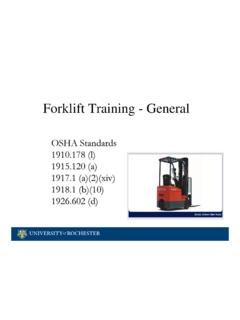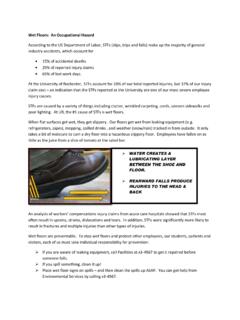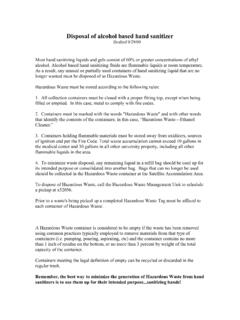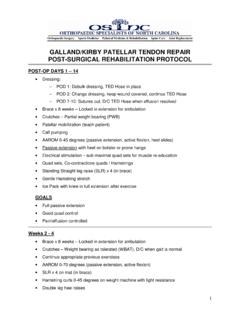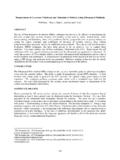Transcription of Patient handling, including lifting, transferring, and ...
1 APPENDIX B. Patient Care lifting Guidelines Patient handling , including lifting , transferring , and repositioning, is covered by SMH. Policy Minimal Lift for Patient handling , which can be found at: The following Mobility Assessment Algorithm, provided in the policy should be used to determine appropriate equipment and assist levels: 12. The decision tree can also be found at: 22%20 Patient %20 Decison% Guidelines for Manual lifting and lateral Transfers Use assistive equipment and devices whenever possible. Do not lift or move patients manually unless there is no feasible alternative. Get help from other staff. Tell patients what they can do to help you. Give them clear, simple instructions with adequate time for response.
2 Before lifting , transferring , or ambulating patients , it is important to perform or obtain an accurate assessment of the Patient 's capabilities and to be aware of any factors, such as fatigue, dizziness, or confusion, which could adversely affect the Patient 's strength, stability, or ability to follow instructions. lifting Whenever possible, mechanical safe Patient handling devices (ceiling- or Hoyer-type lifts) should be used to lift patients . Manual lifting should not be performed unless use of a mechanical lift is medically contraindicated, there is immediate danger to the Patient , or there is no feasible alternative. When there is no feasible alternative to a manual lift, the Patient is in immediate danger, or a mechanical lift is medically contraindicated, use upright, neutral working postures and proper body mechanics: Move obstructions out of the way before lifting .
3 Bend your legs, not your back. Use your legs to do the work. When lifting or moving people, always face them. Never twist your back when lifting . If you must turn, pick up your feet and pivot your whole body in the direction of the move. Try to keep the person, equipment, or supplies you are lifting close to your body as you move. Keep handholds between your waist and shoulders. Move the person towards you, not away from you. Use slides and lateral transfers instead of manual lifting . Use a wide, balanced stance with one foot slightly ahead of the other. Lower the person slowly by bending your legs, not your back. Return to an erect position as soon as possible. Use smooth movements and do not jerk. When lifting with others, coordinate lifts by counting down and synchronizing the lift.
4 13. lateral Transfers of patients Position surfaces ( , bed and gurney, bed and cardiac chair) as close as possible to each other. Surfaces should be at approximately waist height, with the receiving surface slightly lower to take advantage of gravity. Lower the rails on both surfaces ( , beds and gurneys). Use lateral air transfer devices whenever possible. Use draw sheets or incontinence pads in combination with friction-reducing devices ( , slide boards, slippery sheets, plastic bags, low-friction mattress covers, etc.). Get a good handhold by rolling up draw sheets and incontinence pads and use other assistive equipment such as slippery sheets with handles. Kneel on the bed or gurney to avoid extended reaches and bending of the back.
5 Have team members on both sides of the bed or other surfaces. Count down and synchronize the lift. Use a smooth, coordinated push-pull motion. Do not reach across the person you are moving. Guidelines for Ambulating, Repositioning and Manipulating These work tasks are usually performed in or around beds, gurneys, chairs, toilets, showers and bathtubs. Equipment commonly used includes gait or transfer belts with handles (for better grips and stability), pivot discs, draw sheets, and incontinence pads. Using Gait or Transfer Belts with Handles for Patient Maneuvering Keep the individual as close as possible. Avoid bending, reaching or twisting your back when: - attaching or removing belts ( , raise or lower beds, bend at the knees).
6 - lowering the individual - assisting with ambulation Pivot with your feet to turn. Use a gentle rocking motion to take advantage of momentum. Be aware of any signs that the Patient is becoming fatigued, unstable, or confused. Performing Stand-Pivot Type Transfers Used for transferring from bed to chair, etc., or to help an individual get up from a sitting position. Use transfer discs or other assistive devices when available. If using a gait or transfer belt with handles, follow the above guidelines. Keep feet at least shoulder width apart. If the Patient is on a bed, lower the bed so that they can place their feet on the floor to stand. Place the receiving surface ( , wheelchair) on the individual's strong side ( , for stroke or hemi-paralysis conditions) so they can help in the transfer.
7 Get the Patient close to the edge of bed or chair and ask them to lean forward as they stand (if medically appropriate). 14. Block the individual's weak leg with your legs or knees (this may place your leg in an awkward, unstable position; an alternative is to use a transfer belt with handles and straddle your legs around the weak leg of the Patient or resident). Bend your legs, not your back. Pivot with your feet to turn. Use a gentle, rocking motion to take advantage of momentum. lifting or Moving Tasks with the Patient in Bed Some common methods include boosting up or repositioning individuals using draw sheets and incontinence pads in combination with a log roll or other techniques. Whenever possible, safe Patient handling devices such as ceiling lifts equipped with repositioning slings, other mechanical lifting devices, lateral air transfer devices/hover mats, or slip sheets should be used.
8 Adjust beds, gurneys or other surfaces to waist height and as close to you as possible. Lower the rails on the bed, gurney, etc., and work on the side where the individual is closest. Place equipment or items close to you and at waist height. Get help and use teamwork. Guidelines for Transporting patients and Equipment It is often necessary to transport patients in gurneys, wheelchairs, or beds, or handle various types of carts, monitors, instrument sets, and other medical equipment. Decrease the load or weight of carts, instrument trays, etc. Store items and equipment between waist and shoulder height. Use sliding motions or lateral transfers instead of lifting . Push, do not pull. Keep loads close to your body.
9 Use an upright, neutral posture and push with your whole body, not just your arms. Move down the center of corridors to prevent collisions. Watch out for door handles and high thresholds, which can cause abrupt stops. Promptly take out of service any rolling equipment that is defective or in need of maintenance and tag with a description of the problem. Report it to the appropriate department. Guidelines for Performing Activities of Daily Living Cramped showers, bathrooms or other facilities in combination with poor work practices may cause providers to assume awkward positions or postures or use forceful exertions when performing ADLs. Use upright, neutral working postures and proper body mechanics. Bend your legs, not your back.
10 15. Eliminate bending, twisting and long reaches by: Using long-handled extension tools ( , hand-held shower heads, wash and scrub brushes). Wheel people out of showers or bathrooms and turn them around to wash hard-to- reach places. Use shower-toilet chairs, which are high enough to fit over toilets. This eliminates additional transfers to and from wheelchairs, toilets, etc. Use shower carts or gurneys, bath boards, pelvic lift devices, bathtub and shower lifts, and other helpful equipment. When providing in-bed medical care or other services, use the guidelines above. Guidelines for transferring From the Floor lifting a Patient from the floor is extremely hazardous. Unless medically contraindicated, or there is immediate risk to the Patient , use a mechanical assist device such as a ceiling- or Hoyer-type lift, or Hover Jack to lift patients from the floor.





